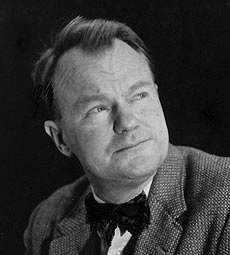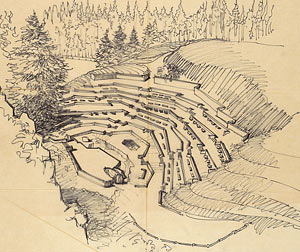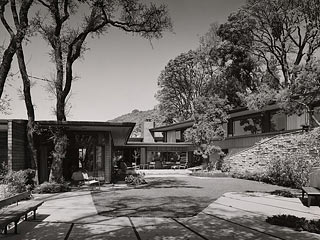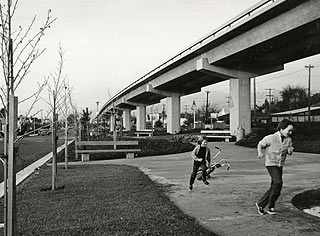UC Berkeley Press Release
Professor and landscape architect Robert Royston dies
BERKELEY – Robert N. Royston, an American landscape architect and a University of California, Berkeley, professor who was known for his designs that focused on space and its use by people in private gardens, planned communities, urban plazas and children's outdoor play areas, died in his sleep at his home in Mill Valley, Calif. on Friday (Sept. 19). He was 90.
 Robert Royston (Photos courtesy College of Environmental Design Archives) |
Royston was a student in the late 1930s in UC Berkeley's landscape architecture program, and during this time he began working weekends with pioneering San Francisco Bay Area landscape architect Thomas D. Church. He continued in the job for two years after his graduation in 1940.
After the bombing of Pearl Harbor, Royston enlisted in the U.S. Navy and spent time in the Pacific theater. In a 1998 interview, he said that the war gave him time to think and that the time he spent in his shipboard cabin designing jewelry, houses and gardens " kept me sane." He left the service with the rank of first lieutenant in 1945.
Next, he opened a landscape architecture firm with Edward Williams and Garrett Eckbo, who had also recently graduated from UC Berkeley and who later became, like Royston, a UC Berkeley professor of landscape architecture. Royston's first major commission, in 1949, was a recreation facility for Standard Oil Refinery (now Chevron) workers near Point Richmond, Calif.
 Royston's Quarry Theater at UC Santa Cruz won a merit award from the American Society of Landscape Architects. |
In 1958, Royston formed the landscape architecture firm of Royston, Hanamoto & Mayes. Eldon Beck joined the team, which included David R. Mayes, soon after. Over the next four decades, the firm went through many changes in name and partnership and is known today as Royston, Hanamoto, Alley & Abey (RHAA).
Royston retired from active practice in 1998, but continued to work as a consultant. He recently was involved in a project restoring one of his rooftop gardens on a high-rise on California Street in San Francisco and another project in Palm Springs, Calif.
 The design for the T. Jack Foster home in Orinda integrated living quarters with the semi-rural community's rolling hills, oak trees and warm climate. |
The Royston materials, dating from 1941 to 1990, formed the basis for a new monograph, "Modern Public Gardens: Robert Royston and the Suburban Park" (2006), by Bay Area landscape architect J.C. Miller and University of Virginia professor of landscape architecture Reuben Rainey.
Underpinning Royston's work were "amazing dynamic forms" and "human-centered designs," said Miller. "He added this extra dimension because he really thought about people," Miller said, adding that contemporary landscape designs may be "hip or green," but to be successful they need to meet the spatial and people-focused principles put forth by Royston more than 50 years ago.
Of particular note in the archives are records of Royston's participation in landscape designs for suburban parks and for individual, affordable and modern mid-century homes in a booming, post-war suburbia that were built by Eichler Homes and T. Jack Foster and Sons of Foster City.
Born April 25, 1918, in San Francisco, Royston grew up on a farm in the Santa Clara Valley and saw parks as "public gardens" for a wide variety of users. Among some of his more important public works were Pixie Place in the Marin County community of Ross, Mitchell Park in Palo Alto, Calif., and Cuesta Park in Mountain View, Calif.
Marc Trieb, a UC Berkeley emeritus professor of architecture, recalled how Royston applied his social and cultural vision to his work, as evidenced in Mitchell Park, where he designed a children's pool that got more shallow the further children paddled from the edge and parental supervision.
 Royston was known for designing for human uses of spaces, such as in the linear park he created under the BART tracks in Albany, Calif. |
Over the years, his landscape design firms has earned more than 70 design awards, among them American Institute of Architects' (AIA) awards for the T. Jack Foster home in Orinda, Calif. (1953) and Hillsdale High School in San Mateo (1956). His firm also received American Society of Landscape Architects (ASLA) merit awards for designs for Quarry Theater at UC Santa Cruz and Sunriver, a 5,500-acre planned community in Oregon.
He was honored in 1975 as a fellow of the ASLA and received the Award of Honor in Landscape Architecture from the City of San Francisco Art Commission. Royston also received the AIA Medal in 1978 and, in 1973, the ASLA Medal, the highest possible award given by that organization. He also earned a Northern California Chapter of ASLA Award for Outstanding Contributions to the Stature of the Profession, and was named an honorary fellow of the Australian Institute of Landscape Architects.
Friends said Royston loved to travel, to dance and to entertain in the garden he designed at his home, hosting lively games of pétanque (a French version of lawn bowling) and taking early morning swims.
Linda Jewell, chair of UC Berkeley's Department of Landscape Architecture and Environmental Planning, said Royston had a perpetual smile on his face. "He enjoyed every moment of his life and that translated into the joy you saw in his landscapes," she said.
Royston approached each of his projects as "the best ever," said J.C. Miller. "There were never any half measures in his work."
He is survived by his wife, Hannelore Gothe Royston of Mill Valley, Calif.; daughters, Michel Ann Royston of Hat Creek, Calif., and Tonia Lee Royston of Oakland, Calif.; son, Curtis Robert Royston of New York City; stepdaughters, Danielle Machotka of San Anselmo, Calif., and Julia Anne Machotka of San Francisco; sister, Doreen Royston Jones of Oakland, Calif., and three grandchildren.
A memorial service is being planned.
In lieu of flowers, Royston's family suggests contributions to the Marin Agricultural Land Trust, P.O. Box 809, Point Reyes Station, Calif., 94956, or the San Domenico School Virtuoso Program, 1500 Butterfield Rd., San Anselmo, Calif., 94960.

